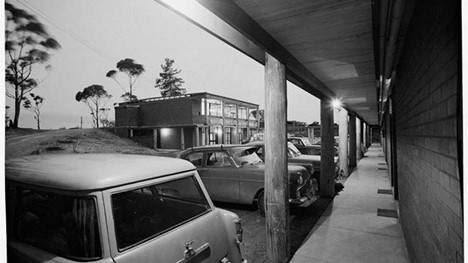South Coast NSW History Story
The Black Dolphin Motel, Merimbula
It Could Have Been ‘The Gay Dolphin’
Merimbula’s Black Dolphin motel (now Tween Waters motel) was considered to be ‘one of the ten best buildings designed and built anywhere in Australia in 1960 – 1961’, ‘the most significant motel building in Australia’, and ‘an original and highly significant architectural response to the native environment’.
It was the brainchild of businessman David Yencken who, at a time when the first motels were being built in Australia, foresaw an opportunity to build and operate motels along the Princes Highway. So, in 1957, he built what was to be the first motel in regional Victoria – the Mitchell Valley Motel on the Princes Highway in Bairnsdale. It provided him with the opportunity to ‘do exciting things with design.’
The motel was immediately successful. ‘There was no need to set out on a major promotional campaign. There was no serious competition from hotels, so it didn’t take long for enough regular commercial visitors to shift their allegiances to the motel and keep it reasonably occupied throughout the year. In the summer months tourists and travellers kept in full’.
Among those who regularly stayed at the Mitchell Valley Motel were three Melbourne businessmen who had acquired an option to purchase a large and attractive site between the inlet and the surf beach at the southern entrance to Merimbula. They asked Yencken to build and then to operate a motel there, based on the key features that he had incorporated into the Mitchell Valley Motel.
Well-known Melbourne architect Robin Boyd was engaged to design the new motel. He consciously attempted to design a building that related to its environment – so retained a group of native mahogany gums in a small courtyard and extensively used locally acquired tree trunks as colonnades for the walkways and as uprights in the main two-storey reception and restaurant building. (Arthur Kaine, a local sawmiller, and after whom Merimbula’s Arthur Kaine Drive is named, subsequently became one of the building group’s Directors.)
The building, to put it politely, ‘was ahead of its time’ and did not immediately appeal to everyone. ‘David Saunders, then a senior lecturer at the architecture school at the University of Melbourne and later Professor of Architecture at Adelaide University, brought a group of architectural students to the motel. ‘Well,’ he said after the tour of inspection had finished, ‘What do you all think of the design?’ One young woman, after hesitating a moment, said: ‘I like the buildings but I think the tree trunks are rather over-designed’. David Saunders walked up to one of the poles and wrapped his arms around it. ‘Dear God’ he said looking to the skies, ‘please don’t do it again.’’
Many of the (few) guests who initially stayed at the motel were confronted by the unusual design and its avant-garde furnishings, so much so that Boyd and Yencken were forced to draft an explanation of what the design was attempting to do (how it related to the bush site, why the buildings were placed as they were, why the materials had been chosen, why the rooms had their ‘different’ layout) and pinned these up on the back of the door to every room. ‘The effect was remarkable; it caused people to think carefully about their previous judgments. Several said to me words of the kind: ‘When we first arrived we didn’t like the place but now that we have been here for a few days we have found the setting and the design increasingly comfortable and relaxing.’’
Yencken soon found he needed to advertise to attract guests to the Black Dolphin motel (‘The Mitchell Valley Motel was a nice name, but unfortunately few people could ever remember it. Thus, the Black Dolphin was chosen after one of those interminable naming discussions. I recall that one of my older fellow directors suggested that it should be called the Gay Dolphin; he was somewhat taken back when I told him what that would imply’), so he ‘asked John Handfield, who had a small but well known public relations and advertising business (in Melbourne, and who lived in a recently-completed house in Eltham that Robin Boyd had designed) to prepare some advertisements for the motel and to suggest their placement. I also asked him if he was interested in a campaign to get more people to use the Princes Highway rather than the Hume Highway. He set about the task with energy and purpose and would have been able to achieve much more if there had been greater support for the campaign from business enterprises that would have gained most from it. I, in turn, tried to get more political support for improvements to the highway. We held a protest meeting in Merimbula attended by local members of parliament...(but) the advertisements for the motel were a disaster. Their flavour was the romantic charm of prawning in the moonlight – suitable perhaps for tropical resorts but not for the Black Dolphin. They attracted no more than a handful of people. Worse, the few people who did come arrived with the wrong expectations and were as a consequence bitterly disappointed. Something different was needed.’
So Yencken then wrote and placed two small, very unusual advertisements in a recently launched magazine called ‘Nation’. These, Yencken concludes, ‘cleverly appealed to an intelligentsia newly awakened, thanks largely to Boyd, to the aesthetic sins of Austerica’.
In time, Boyd and Yencken’s Black Dolphin motel achieved considerable fame and was even used by the government in overseas trade promotions. It was sold in 1965 and, since then, has undergone considerable change - but many of Boyd’s original, groundbreaking design elements have survived.
(David Yencken was also responsible for building Baronda House in Tanja, featured on this website.)
Source: ‘A Tale of Two Motels’ by David Yencken, published in La Trobe Journal, 1993 – 1994, available at https://www.slv.vic.gov.au/sites/default/files/La-Trobe-Journal-93-94-David-Yencken.pdf It is a fabulous, quite funny yarn and so is highly recommended!
